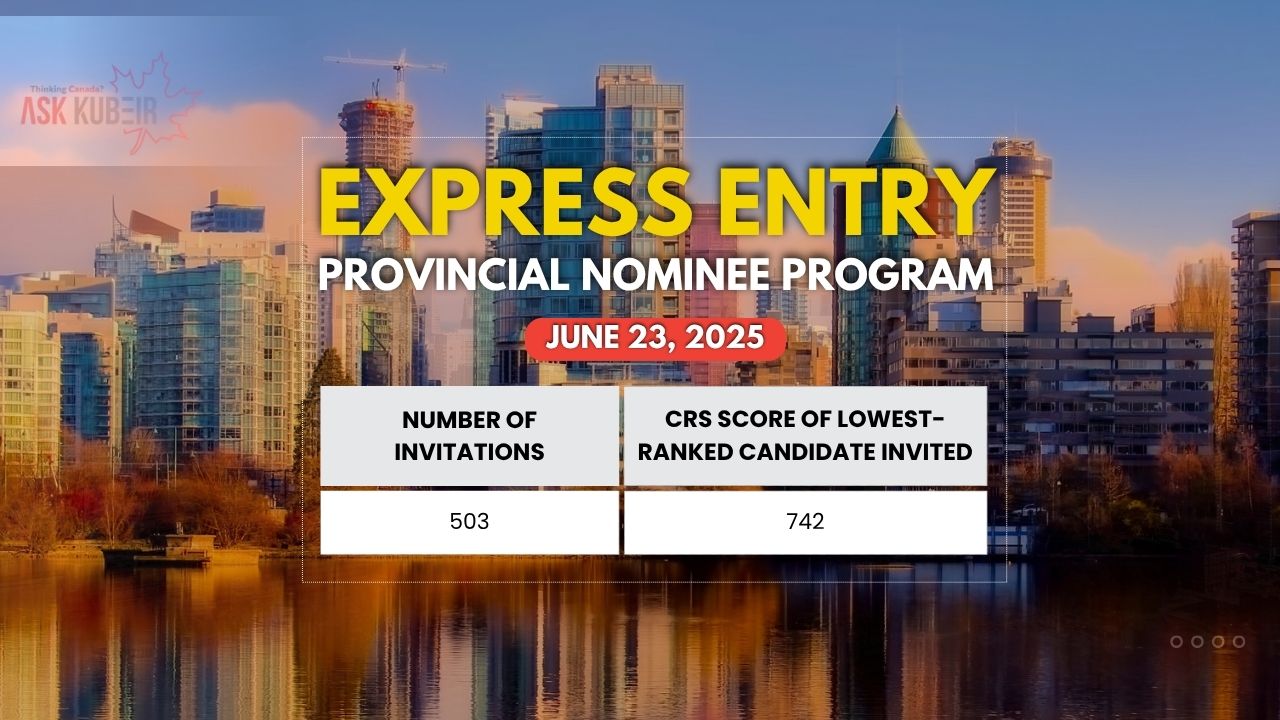
Related Post







Permanent Residence – Canada, through Express Entry
:- Post Credit James King
Permanent Residence in Canada through the Express Entry system. This post would serve as a guide and explain what the process is like, what to expect and what NOT to do when you apply.
I shall update this post from time to time to keep up with the updates that CIC would be throwing at us! I will do my best to keep this post up to date and to keep all the information in this post valid and correct. This post is intended for anyone who wants to get a glimpse of how the process works.
This is basically a 2 step process. You first submit an online Express Entry profile and you receive an ITA and after that, you apply for permanent residence.
So, let’s get started. I shall explain the process in 3 parts: Pre-Application, Pre-ITA, and Post-ITA. (Don’t worry, you’ll soon find out what an ITA is).
I’ll give you guys a brief description of the 3 parts I have mentioned above.
Pre-application phase – A phase where you have NOT created an online Express Entry (hereafter referred to as EE) profile. You do not have a profile number.
Pre-ITA phase – A phase where you have created an online profile and you are waiting to get your Invitation to Apply (hereafter referred to as ITA).
Post-ITA phase – A phase where you have received an ITA and you are all set to submit your Permanent Resident (hereafter referred to as PR) application to Citizenship and Immigration Canada (hereafter referred to as CIC).
PRE-APPLICATION PHASE
You will go through the following in the pre-application phase:
Deciding to come to Canada
Take a piece of paper and write down why you want to come to Canada. Outline your settlement plan; try to research how you would support yourself and the job prospects in Canada. Please do not paint a rosy picture, don’t think Canada will be a land of milk and honey right after you land here. You have to build a life for yourself so DO NOT plan to relax as soon as you get here.
If you are determined to work smart and put in sincere efforts once you get here, you will be a successful immigrant in your new home – Canada.
Check if you are eligible. Determine your eligibility by doing this CIC quiz
http://www.cic.gc.ca/ctc-vac/ee-start.asp
To apply to Express Entry, you must satisfy certain criteria. We shall discuss this below.
You should be eligible under one of the Economic Immigration programs (Federal Skilled Worker Program [ hereafter referred to as FSW/FSWP], Federal Skilled Trades [hereafter referred to as FST] or Canadian Experience Class [hereafter referred to as CEC].
FSWP
FST
CEC
From this point on, I will limit the information to the FSW program alone.
For FSWP, you need to score at least 67 points out of 100 to be eligible. You can manually calculate your points based on the criteria outlined in the CIC webpage (on the link that is provided).
So, are you eligible? Do you score at least 67/100 points? If no, I’m very sorry, you are not eligible to apply under the FSWP. If yes, keep your fingers crossed, you have another set of criteria to satisfy to be eligible for Express Entry.
You must use the Come to Canada tool to check if you are eligible under Express Entry.
Provide answers to the questions and the tool will tell you if you are eligible or not. The basic eligibility criteria are as follows :
A). You need to have your language test results ready (English or French – I shall write a separate post about this later). Get your language test(s) done. You must get at least CLB 7 in each of the four sections for the Federal Skilled Worker (FSW), Provincial Nomination Program (PNP) or Canadian Experience Class (CEC) streams. But getting CLB 10 gives you maximum points for language.
How does CLB match back to the language tests? That info is here –> http://www.cic.gc.ca/english/resources/…/language/charts.asp
B). You need to have an ECA report for your academic degrees/diplomas if they were not obtained from Canada. You can learn about the ECA process.
Get your qualifications assessed by doing an Education Credential Assessment. Details here –> http://www.cic.gc.ca/engli…/immigrate/skilled/assessment.asp
In addition, you can determine the code that best applies to you on the National Occupation Classification (NOC) list http://www.cic.gc.ca/english/immigrate/skilled/noc.asp
The occupation must be NOC 0, A, or B for FSW or CEC.
C). You need to have at least one year continuous, full-time (at least 30 hours per week/1560 hours per year) or equivalent part-time experience in an occupation that is categorized under NOC 0, A or B in the past 10 years.
D). You need to have unfettered access to sufficient funds (that are unencumbered) depending on your family size (for the case in point here, “dependents” include your spouse and your dependent children). This money may not be borrowed from another person. You can check how much funds you need (here)
So, what does the tool say? Are you eligible? No? I’m sorry, you can check if you are eligible under any other immigration program.
If yes, congratulations, you have cleared one hurdle on your path to attaining your Permanent Residence. You will receive a code that is called the “Personal Reference Code”. You need this to create your online EE profile.
CREATING YOUR EXPRESS ENTRY PROFILE on the CIC platform:
Congratulations! You are eligible and all set to create your online Express Entry profile. To proceed you will need a couple of things:
A). As mentioned before, you would need the Personal Reference code.
B). You need to create a myCIC account if you do not have one already. (Link here)
C). You will need your language test’s Test Report Form (hereafter referred to as TRF) number AND your ECA report number to create and submit a complete profile.
D). You may also register with Canada’s “Job Bank”. This can help you search for jobs before you arrive in Canada. Registration in job bank is no longer mandatory.
Please note that you need a login credential to create a myCIC account; you can login through a sign-in partner or by creating a GC key.
You will have created your profile by now. Now you have to sit down patiently and wait for your ITA. The odds of getting an ITA are directly proportional to your CRS. Higher your CRS, the higher the chances of getting invited. This is the end of the pre-application phase.
PRE-ITA PHASE
As I have already mentioned before, this phase requires you to wait and have patience. Roughly speaking, CIC conducts draws twice a month. The Minister of Citizenship and Immigration decides the cut-off score for the particular draw. You can see the rounds of invitations (here). If your score is greater than or equal to the cut-off score selected by CIC, you will get an ITA.
One thing that you’ll have to do here is to keep an eye on the draws and your CRS. You have to see how close you are to the previous/recent draws. The link to the official draw page is here. I must admit that CIC is extremely unpredictable in this regard; the draws can be random and the CRS cannot be predicted in advance, so to speak. So, depending on your CRS, you might want to consider applying for Provincial Nomination, which has been discussed at the end of this section.
In the pre-ITA phase, you can start collecting the documents that you are expected to submit once you get an ITA. Some of the documents that you can prioritize getting are Police Clearance Certificates and your Employer reference letters. I will be discussing this in detail below.
A) Police Clearance Certificates or PCC as they are known as, are required for the primary applicant, spouse, and children over 18 years of age from their country of residence AND all other countries where they have been for a continuous period of 6 months or more. Getting a foreign PCC can be a tedious and painstakingly long process so it is imperative to be proactive to avoid delays and get things done on time. PCC issued by a foreign county is valid indefinitely if it was issued during or after your last visit to that country. Please note that local PCCs can be obtained after you receive the ITA because it usually takes less time.
B) Employer Reference letters are required for the PA. The reference letter must be as specified by CIC. You can find the details of what the reference letters should be like in the link provided at the end of this section.
Depending on where the applicant works, the time is taken for employers to issue these reference letters vary. So, it is important to be prepared and apply for the reference letter at the earliest. Please note that reference letters issued by employers while you quit the job are valid indefinitely while the reference letter issued by your current employer is generally valid for one year.
C) Proof of funds (POF) is a very important part of your documentation. While you are awaiting your ITA, you can prepare to show your funds. You DO NOT need to get any bank letter/document at this stage but if you need to arrange funds (like selling a car or liquidating assets like selling gold etc.) you have to start planning on how you are going to show your funds. CIC requires that the funds be unencumbered by any debt or obligation to re-pay. These funds must be liquid (You should be able to convert it to hard cash whenever required). You can see what CIC allows you to show as POF in the link provided at the end of the section.
D) Provincial Nominee Program (hereafter referred to as PNP) can be put to use if you think your CRS is not up to the mark. PNP is the immigration scheme of the provincial/territorial governments by which they pick applicants who they think are suitable to fulfill the demand in their province. Some provinces require a full-time job offer from a Canadian Employer and some don’t. Some provinces process the applications electronically and some provinces still use the old-school snail-mail method. Some provinces prefer applicants whose job falls under a particular NOC. There is variety. You can check the website of the province that you are interested in to learn more. If you get a provincial nomination, it will add 600 points to your CRS which means, in most cases, you will get an ITA in the very next draw.
Alright! So you have certain documents ready and Voila! You received an ITA. Great! Your next step is to accept the ITA and file your PR application electronically (e-APR).
Please note that if you will not be able to submit any of the necessary documents, you must consider declining the ITA and re-enter the pool to get another ITA.
We have now come to the end of the pre-ITA section.
POST-ITA PHASE (List of required documents is here)
This is a very important phase and this is where your application will either be accepted or rejected. Once you get an ITA, you have 60 days to file a complete application – e-APR (electronic – Application for Permanent Residence). You need to gather all the required documents. You need to undergo a medical test (The details of the test are outlined later in the section). Once you submit a complete application, CIC will determine if you will receive a visa or not within a period of 6 months or less.
POF/Reference letters can be obtained post-ITA too (depending on your personal circumstance).
A) A medical examination is, by far, one of the most important post-ITA processes. The medical test is to ensure that you or your dependents do not have any serious/contagious diseases AND you will not be a burden to the Canadian healthcare system initially. You and all your dependents (whether accompanying or not) MUST undergo a medical test. Please note that this medical test must be performed by a doctor who is a CIC designated panel physician. Pregnant applicants or applicants can choose to complete their medical exam after the baby is born (since chest X-ray is a part of the tests) OR can choose to go ahead with the tests by wearing a lead apron. After the tests are done, you will get an upfront medical form. You will upload this form along with the other documents on the checklist.
B) Passports/Travel Documents must be submitted for the PA, spouse and for dependent children.
These two, along with other documents mentioned above (and in the checklist) must be submitted as a part of your post-ITA documentation.
Alright! So now you have all the documents available in the checklist. You are now all set to submit your application. Please follow the instructions given by CIC very carefully and fill the online application. Upload all the required documents. When you feel the need to explain something to CIC (like large recent deposits on your account or any other unusual circumstance), PLEASE submit a Letter of Explanation (LOE) along with the documents so that the officer who is assessing your case understands why you have not submitted the document in the prescribed format/why you are submitting an alternate document. Remember, you only have 60 days to submit your application. If you do not submit a complete application within this period, the validity of your ITA will lapse. You would then need to re-enter the pool and wait for a brand new ITA and have to start your e-APR from scratch.
Any changes to your personal circumstance (like the pregnancy of self/spouse, the birth of a child, death/divorce etc.) MUST be reported to the VO at the earliest. If you DO NOT report these changes, it amounts to misrepresentation and your application will be rejected and you will be barred from re-applying again for 5 years.
After you submit your application, your medical records are checked. If everything is fine, your application goes into processing. At this stage, background checks are performed. CIC might sometimes choose to call your employer to verify your employment history if they feel they need to verify. If the VO feels he/she needs more information, then you will be asked to upload further documents. You *might* be asked to attend an interview if the need be. If everything goes fine, you will get a Passport Request (PPR) and a Decision Made (DM) within 6 months of submission of a complete application.
You can submit your passport (along with dependents’ passport, if they are accompanying you to Canada) at the nearest VFS. They will send your passport to the embassy and deliver your passport back to you after the stamping is done. You will get a Confirmation of Permanent Residence (COPR) letter along with your passport that is stamped with the Maple Leaf Visa. You need to carry BOTH your passport(with the stamped visa) and the COPR when you are traveling to Canada.
Please ensure that you verify all the details on your Visa and COPR. If there are any discrepancies, report it to your VO at once.
Please note that you and your dependents MUST land in Canada before your (and their) medical test expires (The validity of the medical test is 1 year from the date of the test) OR before your current passport expires, WHICHEVER COMES FIRST. Also, please note that the dependents can either land ALONG with the PA or at a later date after the PA has landed BUT UNDER NO CIRCUMSTANCE CAN THE DEPENDENTS LAND BEFORE THE PA LANDS.
I pray you to find the above information very useful.
